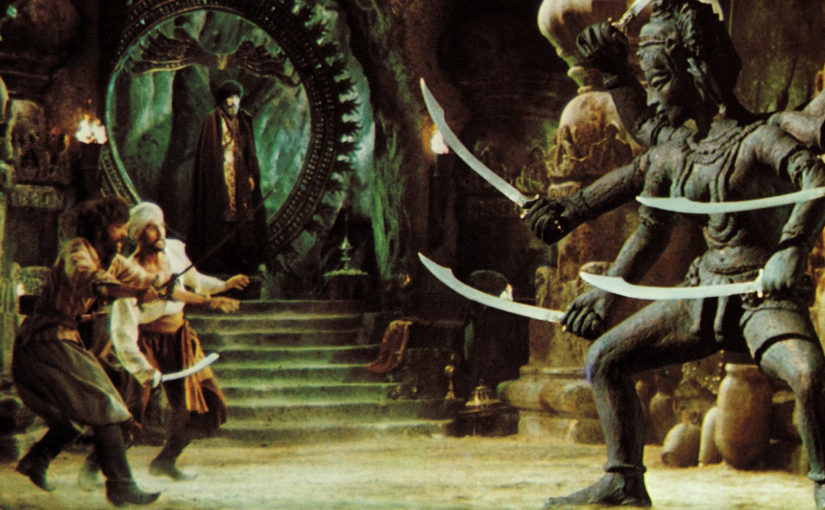I have composed a number of posts that involved special effects by Ray Harryhausen. I listed them simply because, as a boy, the visuals and the adventure that was portrayed in the movies greatly appealed to me. They influenced me. Which was something that is most certainly lacking in the latest Hollywood fare. (That is, unless you are an LGBT with an inferiority complex.)
Here, I want to discuss another of his great works. The Golden Voyage of Sinbad.
Sinbad and his crew intercept a homunculus carrying a golden tablet. Koura, the creator of the homunculus and practitioner of evil magic, wants the tablet back and pursues Sinbad. Meanwhile Sinbad meets the Vizier who has another part of the interlocking golden map, and they mount a quest across the seas to solve the riddle of the map, accompanied by a slave girl with a mysterious tattoo of an eye on her palm. They encounter strange beasts, tempests, and the dark interference of Koura along the way. -AVXHM
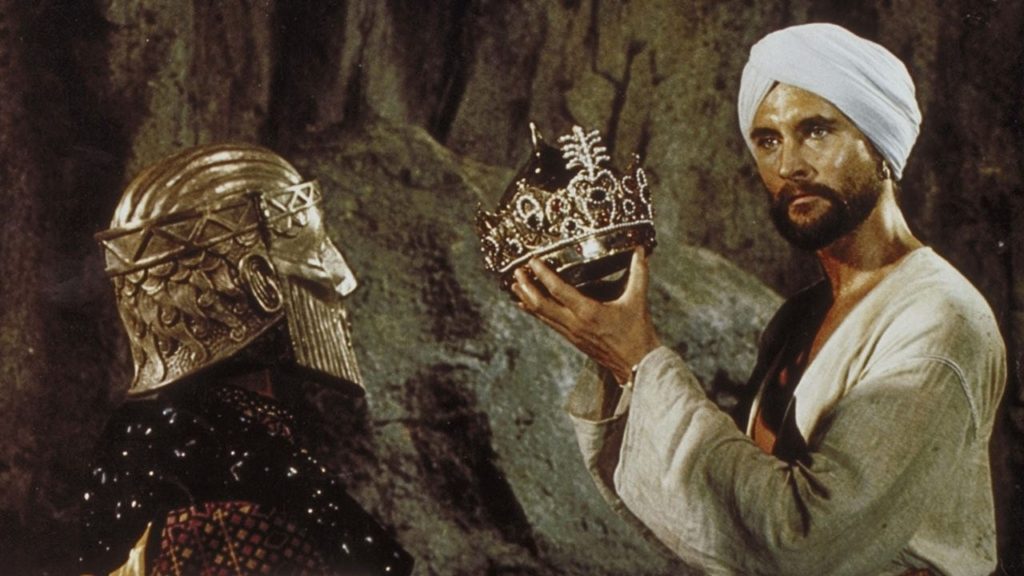
The Movie
It all starts to unravel when Sinbad fires an arrow at a strange creature that flies over his ship.
As the creature dodges the arrow, it ends up dropping an amulet it is carrying. Let me pause here for a second. A strange creature? It’s carrying a magic (we suppose, after all what other purpose would an amulet have) amulet, which it drops, and Sinbad gathers up.
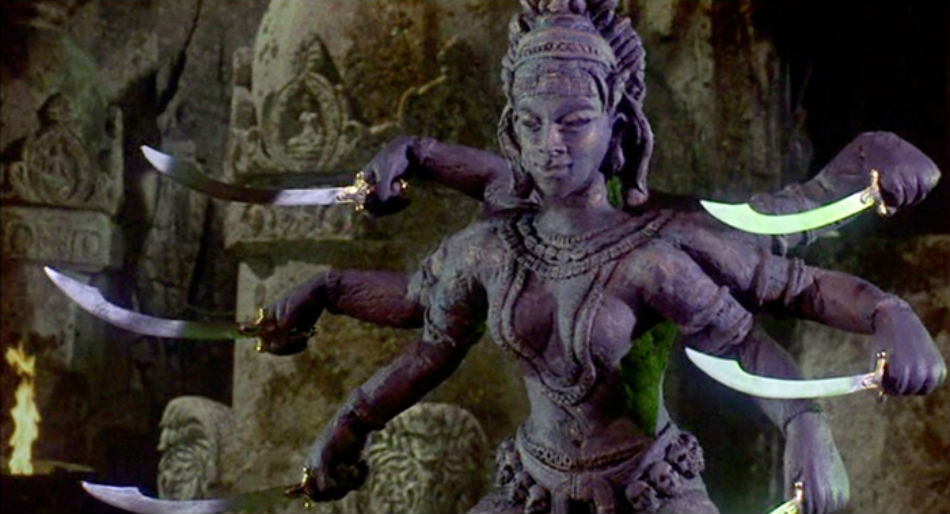
Sinbad makes landfall, and almost immediately meets an evil sorcerer. We know he is evil because he immediately engages Sinbad in fisticuffs. His attempts to forcibly take the amulet from Sinbad is rebuffed.
The sorcerer’s name is Koura. He’s a fellow that you don’t want to get tangled up with.
So Sinbad seeks out a safe haven, and is eventually granted refuge by the benevolent ruler of the city, known as the Grand Vizier. This fellow too has tangled up with Koura. For today he has been forced to hide his face behind a beaten gold mask. You see, his face is all terribly disfigured after Koura burnt it away with a fireball.
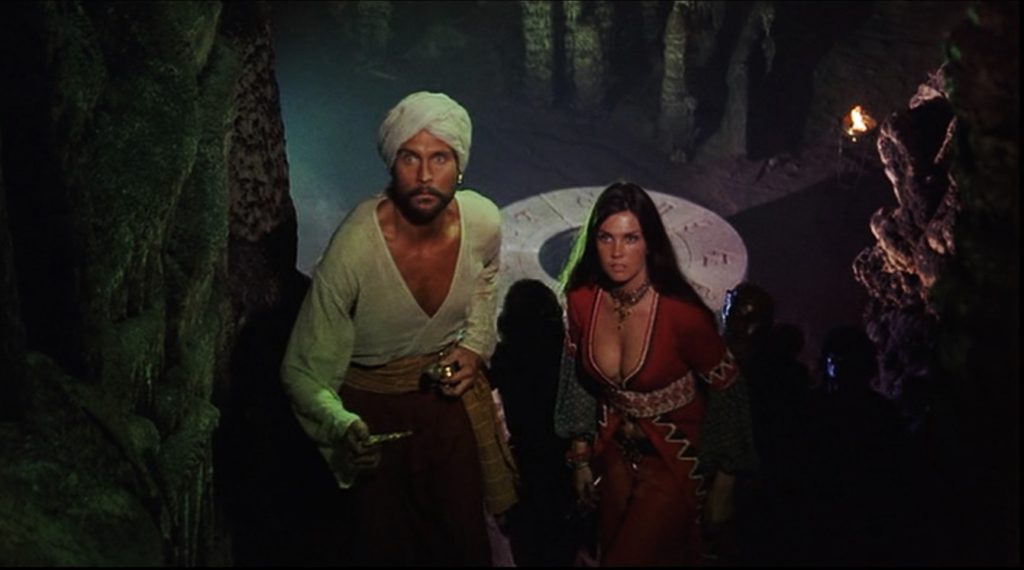
The Vizier shows Sinbad a companion amulet and the drawing of a third one. All three amulets form a map that leads to a fountain of youth on the island of Lemuria.
Harryhausen’s creations include the winged, miniature homunculus; an ensorcelled figurehead that tears itself loose from Sinbad’s ship; a one-eyed centaur; a gryphon that guards the Fountain of Destiny; and, most impressively, a six-armed statue of Kali which performs an Indian dance before dueling against Sinbad’s men with six swords. It’s really the Kali sequence that makes this such a memorable film. With his typical attention to detail, Harryhausen hired an Indian dancer (Surya Kumari, also a noted actress and singer) to choreograph and perform as Kali with one of her students strapped to her back. The dance was then scored with Indian musicians, and the sudden switch in flavor (as our ears have already been conditioned to an hour or so of Rózsa’s romantic adventure music) is in synch with the charged, magical atmosphere of the statue coming to life. For the swordfight, nearly as elaborate as the celebrated skeleton battle in Jason and the Argonauts, stunt choreographer Fernando Poggi tied three of his men together to rehearse the action with the actors, then removed themselves and let the actors shadow-box before the cameras, with Harryhausen’s Kali to be added later. It’s a showstopping fight and, it must be said, far more rousing than the typical poke-with-spears action that so many Harryhausen action scenes become (or, in fact, the earlier scene with the ship’s figurehead). It’s one for the highlight reels. -Midnight Only
With the complete amulet, The Grand Vizier will be able to stop Koura’s ravages on the kingdom. And so Sinbad and the Vizier set sail on an expedition to Lemuria.
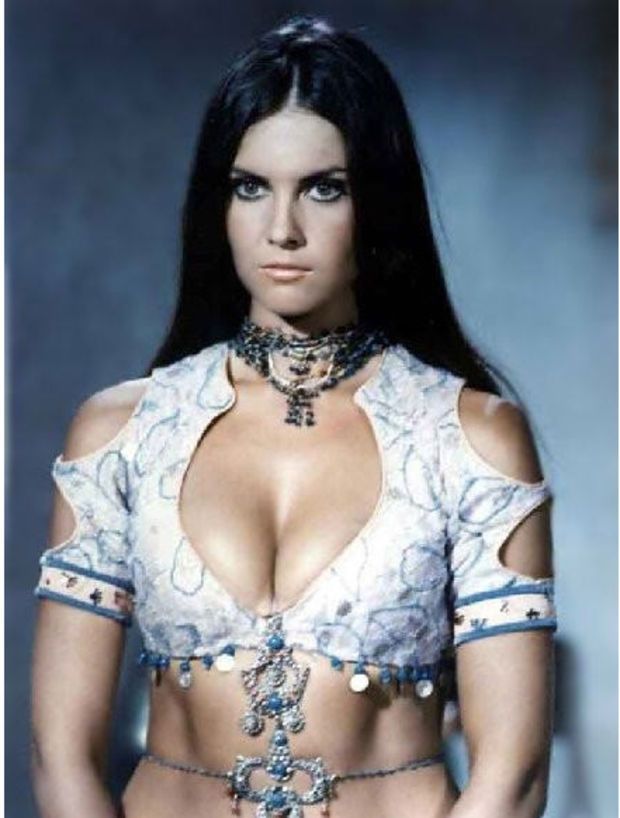
However, Koura desires the amulet too. As all bad guys learn sooner or later, there is a price when using dark magic. His use of the amulet has taken it’s tool. For each time he used it, a little bit of life was stolen from him. Thus, he needs and covets that amulet in the vain hope of regaining his youth. You know, the youth and life that each spell he casts steals from him.
Koura sets sail determined to stop them. And thus, the adventure movie begins…
Some Background
It all sort of began with the movie The 7th Voyage of Sinbad (1958). This movie was a landmark in fantasy cinema, and was often imitated over the next decade.

Most importantly, it brought to prominence the name of special effects man Ray Harryhausen and his fantastical creatures. Now, Ray Harryhausen was more than just a specialist in the process of stop-motion animation. He was a genus. Here, it is much like claymation. Created figurines are meticulously moved and photographed one frame at a time.
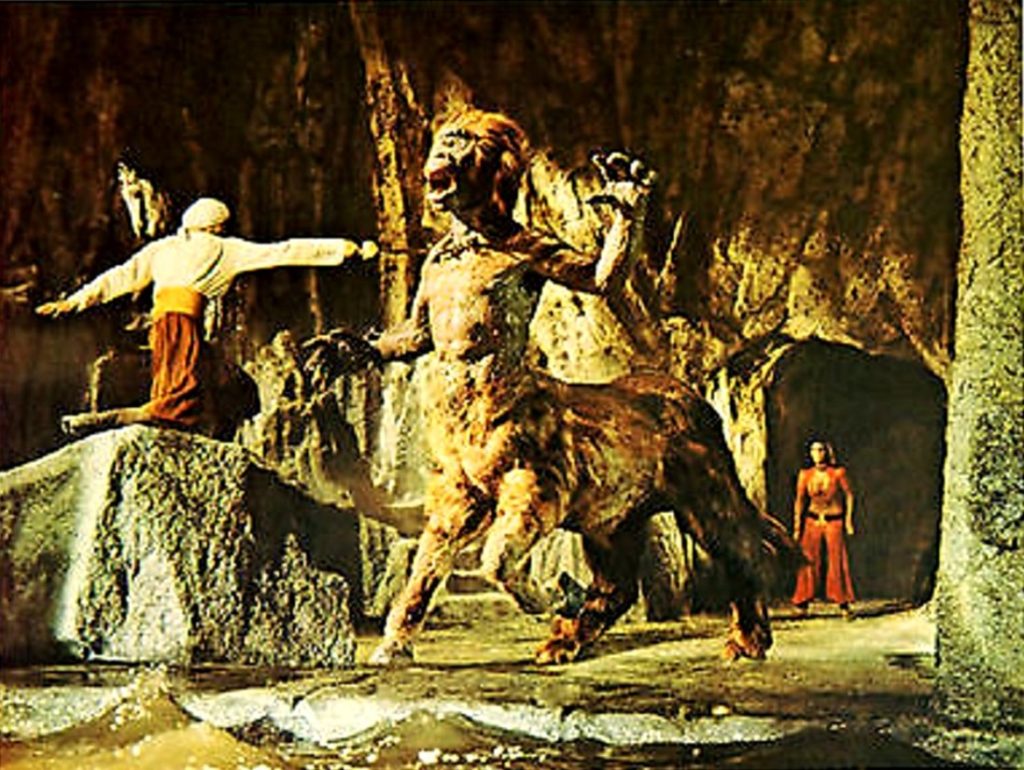
He was so successful at it that Harryhausen went on to build a substantial career in this field over the next two decades.
He found a nitche in the world of Greek mythology. He would revisit the Sinbad mythos twice, here and later with the movie Sinbad and the Eye of the Tiger (1977). The Golden Voyage of Sinbad is one of Ray Harryhausen’s most acclaimed works and one that shows him at the height of his art.
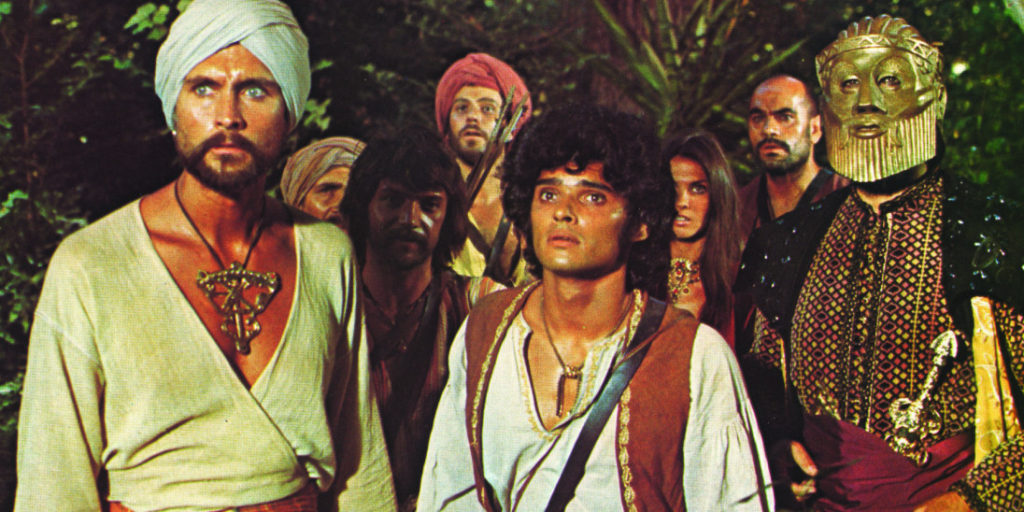
Most Ray Harryhausen films tend to be set around Harryhausen’s provision of profound creature effects. Which unfortunately tended to make the real actors and their intervening action rather wooden. However, as a child watching these movies, I noticed none of that.
The same is true with the dialog. No matter how chunky or cheesy it appeared, it always appealed to me. The quest for adventure screamed at me, and the livid monsters occupied my young impressionable mind.
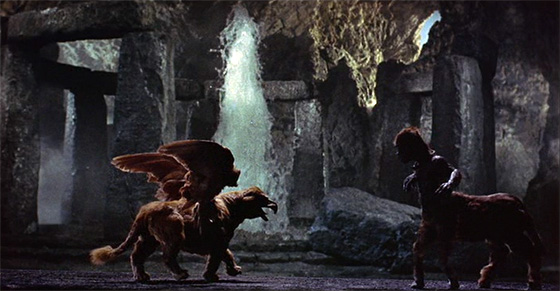
When I was a child, The Golden Voyage of Sinbad (1973) and Sinbad and the Eye of the Tiger (1977) were one and the same – a four-hour Sinbad miniseries, with all the islands, wizards, beautiful girls, and Ray Harryhausen monsters randomly distributed so that I wasn’t exactly sure which belonged to which. Understand that every trip to the video store meant that I would stand there, staring at all the boxes, ruling out the R-rated films or anything that looked remotely adult (verboten when I was a child), and eventually, inevitably, I would grab a Ray Harryhausen movie and hand it to my mother or father, who would just say, “This one, again?” Jason and the Argonauts (1963), Mysterious Island (1961), or a Sinbad movie. These films were the foundation stones upon which my imagination was built. Even though the early 80’s belonged to George Lucas and Steven Spielberg, I always held the Harryhausen films in special regard. Before I even learned his name, I knew these films were connected – I recognized the stop-motion animation and the look of the monsters. (Of course that centaur only has one eye. He’s probably related to those cyclopes in The 7th Voyage of Sinbad.) These films had special special effects. Having watched just about every non-R-rated fantasy movie on the video store shelves, I knew there was a significant difference between One Million B.C. (1940), the Victor Mature movie with lizards and armadillos posing as dinosaurs, and One Million Years B.C. (1966), the remake with Harryhausen’s pterodactyls lifting Raquel Welch off the ground. You can’t dress a lizard up to look like a pterodactyl. The funny thing is that I was appreciating the films from a point-of-view that was already becoming outdated. The days of stop-motion were coming to an end, with his swan song, Clash of the Titans (1981), released around the time that I was just beginning to appreciate his films. Though both Lucas and Spielberg used stop-motion effects in Star Wars (1977) and Raiders of the Lost Ark (1981), by the end of the decade The Abyss (1989) would announce a new direction for cinema tricks. -Midnight Only
Both Brian Clemens and Ray Harryhausen plunder world mythology somewhat indiscriminately. Which more often than not resulted in a kind of peculiar multi-cultural polyglot. Not that it matters, of course, but it is curious.
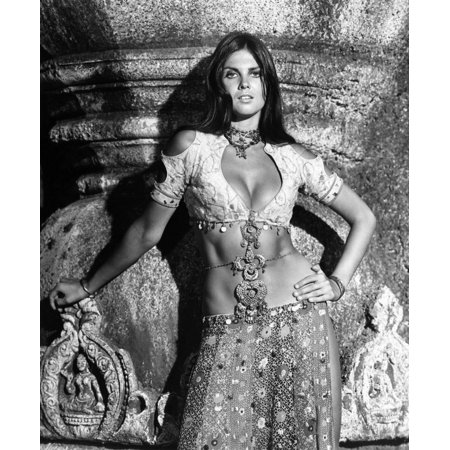
Today, as an adult, I guess that I am more of a purist. But as a kid, nah… who the heck cared? Consider their broad paintbrush. There is Kali from Hindu religion, a griffin and combination centaur/cyclops from the Greek myths, the homunculus from mediaeval alchemy, Lemuria, and of course the backdrop from the Arabian Nights cycle.
As an aside, did you know that the idea of Lemuria was first posited by biologist Ernst Haeckel in the 1870s. It preceded the notion of continental drift. It was used with the belief of a sunken land in order to explain how lemurs managed to get between Africa and India. Later, this theory was bastardized and quickly appropriated by the 19th Century Theosophist movement.
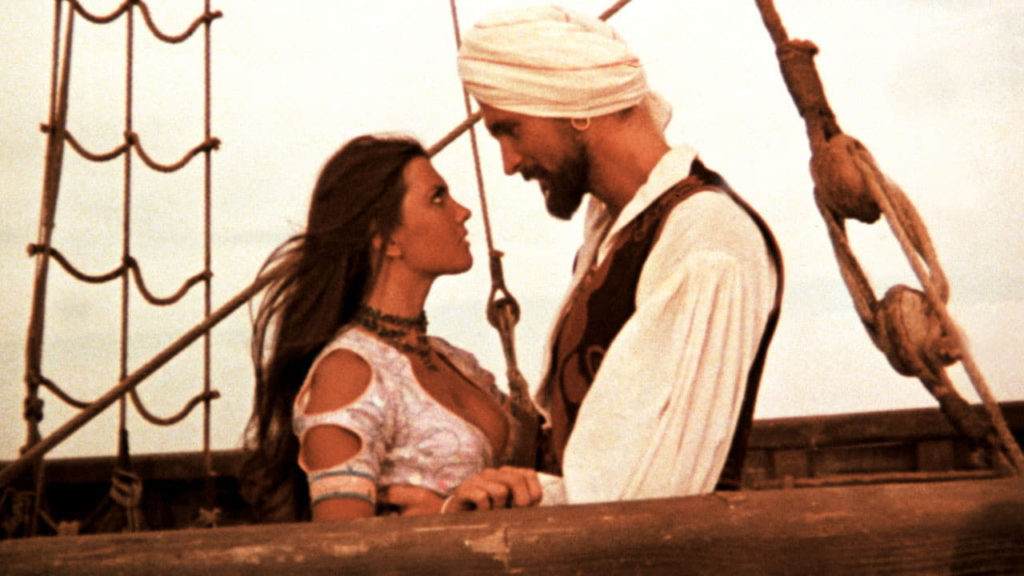
All of this trivality is far less important than the spectacular beauty of Ray Harryhausen’s various set-pieces. Which, by this time, were at the absolute peak of their form.
Harryhausen offers us [1] a six-armed statue of Kali brought to life in a sword-duel; [2] a to-the-death battle between a griffin and a cyclopean centaur; [3] a magically animated ship’s figurehead; and, best of all, [4] the homunculus that Tom Baker brings to life, teasing and prodding it, as it lies pinned to a table.
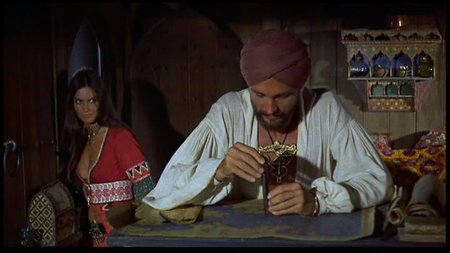
Harryhausen, who made this film with his longtime collaborator and co-producer Charles H. Schneer, was careful to separate this film from 7th Voyage; he seemed to dislike the label of “sequel.” (In his 2003 book An Animated Life, Harryhausen states that he and Schneer even “strenuously” tried to avoid the term regarding Eye of the Tiger, curiously enough.) Indeed, the viewer need not have seen the former film, though naturally it exists in its shadow. The 7th Voyage of Sinbad is a classic of fantasy filmmaking to stand beside its chief inspiration, The Thief of Bagdad (1940). Golden Voyage is just another fun Harryhausen movie, the perfect way to pass a Saturday afternoon. Law does a credible job as our new Sinbad (replacing 7th Voyage‘s Kerwin Mathews), embodying Harryhausen’s image of the Arabian Nights hero: handsome, athletic, but not a bodybuilder. The story, conceived by Harryhausen and revised, polished, and scripted by Brian Clemens (of the TV series The Avengers, as well as Captain Kronos, which also featured Caroline Munro), sends Sinbad on a treasure hunt on behalf of a disfigured Vizier in a golden mask (Douglas Wilmer, Jason and the Argonauts). Their quest involves retrieving the lost pieces of an amulet, which will point the way to an ancient, magical source of great knowledge and power. There’s always an evil magician in pursuit, of course, and in this case it’s Baker’s Prince Koura, who controls gargoyle-like homunculi and lusts after the same prize. The story might be perfunctory, but it’s well-paced, with attractive location shooting in Spain to stand in for both the fictionalized Middle East and Lemuria. (Plans to shoot in India – which would have provided a wonderful look to the film – were discarded after hearing horror stories about “appalling red tape and bureaucracy” encountered by other Hollywood productions shooting there.) Composer Miklós Rózsa (The Thief of Bagdad, Ben-Hur) is the ideal stand-in for 7th Voyage‘s Bernard Herrmann, capturing the appropriate “Orientalist” feel. -Midnight Only
The Golden Voyage of Sinbad is also notable for many of the up-and-coming stars. There is Tom Baker who, the following year, would become the fourth incarnation of tv’s Doctor Who (1963-89). There is cult queen Caroline Munro; and Martin Shaw, later hunk hero of Clemens’ superior action man tv show The Professionals.
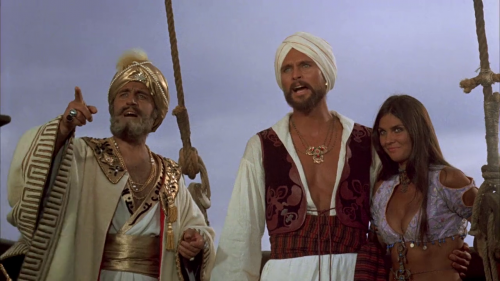
Conclusion
This is a great movie to introduce the kids to, to spend a lazy hazy august afternoon, or just to relax to. There are some amazing scenes, and nowhere else in movie-land will you see a six-armed statue of Kali which performs an Indian dance before dueling against Sinbad’s men with six swords. I enjoyed it and I think that maybe you the reader would enjoy it as well.
Ray Harryhausen’s other films
- The Beast from 20,000 Fathoms (1953), the granddaddy of all atomic monster films;
- the giant atomic octopus film It Came from Beneath the Sea (1955);
- the alien invader film Earth Vs. The Flying Saucers (1956);
- the alien monster film 20 Million Miles to Earth (1957);
- The 7th Voyage of Sinbad (1958);
- The 3 Worlds of Gulliver (1960);
- the Jules Verne adaptation Mysterious Island (1961);
- the Greek myth adventure Jason and the Argonauts (1963);
- the H.G. Wells adaptation The First Men in the Moon (1964);
- the caveman vs dinosaurs epic One Million Years B.C. (1966);
- the dinosaur film The Valley of Gwangi (1969);
- Sinbad and the Eye of the Tiger (1977);
- and the Greek myth adventure Clash of the Titans (1981).
Links
Torrent Links
You can watch it for free if you don’t mind waiting a half an hour to half a day to download the torrent.
For those of you who are unaware. Torrents are parts of files that are spread out in tiny packets all over the internet. You use a "Bit Torrent" client to vacuum up all those little bits and pieces of the file. It then assembles the file into a movie that you can watch. The time that this takes can vary from a few minutes to weeks depending on how popular or obscure your searched file is.
You will need an application to manage the download. I recommend the free application VUZE. To download the video is thus easy. Install VUZE, and then click on one of the following torrent links.
- Download The Golden Voyage of Sinbad (1973)
- 신밧드의 대모험
- Download The Golden Voyage of Sinbad (1973) YIFY Torrent
- The Golden Voyage Of Sinbad (1973) – ZTMovies
- Download The Golden Voyage Of Sinbad (1973) 720p BluRay
- The Golden Voyage of Sinbad 1973 720p EN-SUB x264
Depending on where you live, you might not have the freedom to access these sites and the ISP might block them from access, or the search engines might black out their search results. Americans, in particular, might have some real problems. Therefore, I listed the most accessible torrent sites available to Americans. Pirate Bay and 1337X. I think that Kick Ass Torrents is still blocked for all Americans.
Movies that Inspired Me
Here are some movies that I consider noteworthy and worth a view. Enjoy.


Stories that Inspired Me
Here are reprints in full text of stories that inspired me, but that are nearly impossible to find in China. I place them here as sort of a personal library that I can use for inspiration. The reader is welcome to come and enjoy a read or two as well.
































My Poetry

Articles & Links
You’ll not find any big banners or popups here talking about cookies and privacy notices. There are no ads on this site (aside from the hosting ads – a necessary evil). Functionally and fundamentally, I just don’t make money off of this blog. It is NOT monetized. Finally, I don’t track you because I just don’t care to.
- You can start reading the articles by going HERE.
- You can visit the Index Page HERE to explore by article subject.
- You can also ask the author some questions. You can go HERE to find out how to go about this.
- You can find out more about the author HERE.
- If you have concerns or complaints, you can go HERE.
- If you want to make a donation, you can go HERE.

